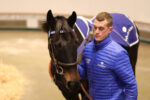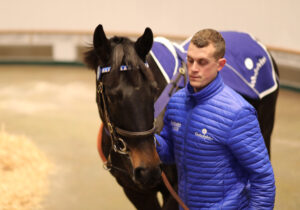The history of Ballylinch Stud is a long and storied one dating back to the time when Major Dermot McCalmont retired his brilliant and unbeaten colt The Tetrarch in 1915 to stand at his private residence, the Mount Juliet estate, near Thomastown in County Kilkenny. It’s a very different world to the one back then but with great care taken to appreciate its heritage and preserve the property as it was over 100 years ago, it’s not too far fetched to think that McCalmont would recognise the farm in its current guise under the ownership of American John Malone.
Undoubtedly McCalmont would also enjoy and identify with its current success, which spans a thriving stallion roster that consists of three Group 1-producing sires, an Arc winner and Group 1-winning miler alongside a high-flying 70-strong broodmare band and collection of 30 horses in training headed by the Prix de l’Opera heroine Place du Carrousel. Ballylinch has long dined at racing’s top table, in particular for the past three decades under the eye of managing director John O’Connor. However, even by its own high standards, 2022 has been a year to savour, not least thanks to the Group 1 sweep of Bayside Boy and Bay Bridge in the Queen Elizabeth II Stakes and Champions Stakes on Qipco British Champions day at Ascot; not only are both sons of resident sire New Bay but both raced for the stud in partnership with an eye towards their future stallion career.
“It was one of those unusual days,” recalls O’Connor of that October afternoon. “The two New Bays won at Ascot and then a homebred that we have with Willie McCreey called Self Believe won a Listed race [the Trigo Stakes] at Leopardstown. All three runners that we had won. We’ve never had a day like that before.”
“It was one of those unusual days”
In the case of Bay Bridge, he had the mighty Baaeed to overcome in his assignment in the Champion Stakes. Bought into last winter to race on in partnership with his breeder James Wigan, the Sir Michael Stoute-trained colt immediately underlined the value of that transaction by winning the Brigadier Gerard Stakes at Sandown in May before running second to State Of Rest in the Prince Of Wales’s Stakes. A niggle picked up when behind Vadeni in the Eclipse Stakes temporarily derailed his four-year-old campaign, meaning that he had an absence of 105 days behind him upon his return in the Champion Stakes. Yet defy it he did, travelling comfortably in the hands of Richard Kingscote to take it up early in the straight and hold off the persistent challenge of Adayar with Baaeed back in fourth.
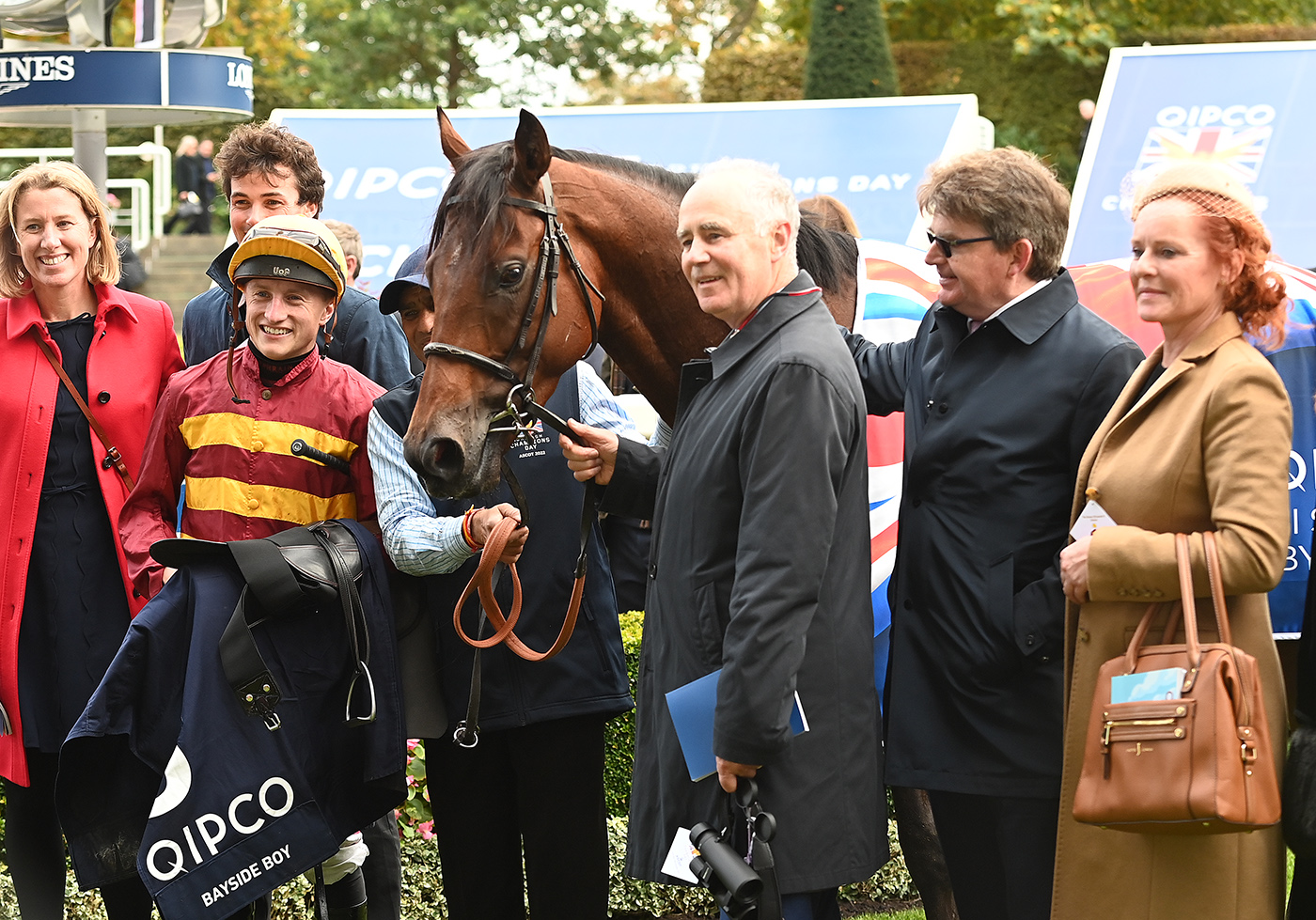
Bayside Boy pictured with connections, including John O’Connor (to the right of the horse), following his win in the Queen Elizabeth II Stakes. Photo – Bill Selwyn
“Sir Michael Stoute was very positive going into the race,” says O’Connor. “He was working well and pleasing everyone at home.
“He’ll stay in training next year. Sir Michael was keen to have him again. And if he gets a clear run, he’ll turn up in all the big ten furlong races across Europe. I think he’s still progressing. He came out of the Eclipse with a bit of a niggle which meant he had to miss some of those good races in the summer. But he’s well capable of running fresh, as we saw in the Brigadier Gerard and again in the Champion Stakes.
“He’s a very good-looking horse – big and powerful with a very good temperament. He has a superb attitude, a real will to win. That was the case at Ascot, he kicked and was always holding them.”
Bay Bridge’s win set the seal on a remarkable day – and season – for Ballylinch’s young ascendant stallion New Bay. Bay Bridge is from his first crop, bred off a fee of €20,000, as is this year’s Prix Rothschild winner Saffron Beach, also successful in last year’s Sun Chariot Stakes, and the Group 2 winners Jumby and New Mandate. Just as impressive is his second crop, which is headlined by Bayside Boy and also includes the German champion two-year-old Sea Bay alongside this year’s Hampton Court Stakes winner Claymore.
Hindsight is a wonderful thing but it’s no exaggeration to say that New Bay possessed the ingredients to be successful at stud as a Classic-winning son of Dubawi from the deep Juddmonte family of the Group 1-producing sires Kingman, Oasis Dream and Beat Hollow, the latter of whom successfully formerly fulfilled a dual-purpose role on the Ballylinch roster.
“I really like a horse with a turn of foot,” says O’Connor. “The ability to accelerate is huge in a turf horse.
“New Bay was very highly regarded by Andre Fabre. When we went to look at him, Andre was very positive about him – he said to me ‘you should buy this horse’. He had a serious turn of foot, which we saw in both the French Guineas, in which he came from last from a wide draw to be second, and then when he won the Prix du Jockey Club. He was effective at a mile, a mile-and-a-quarter, and he was also third in the Arc over a mile-and-a-half. So he was very versatile and I think we’re seeing that in his progeny as well. On average, he also speeds the mares up a little bit.”
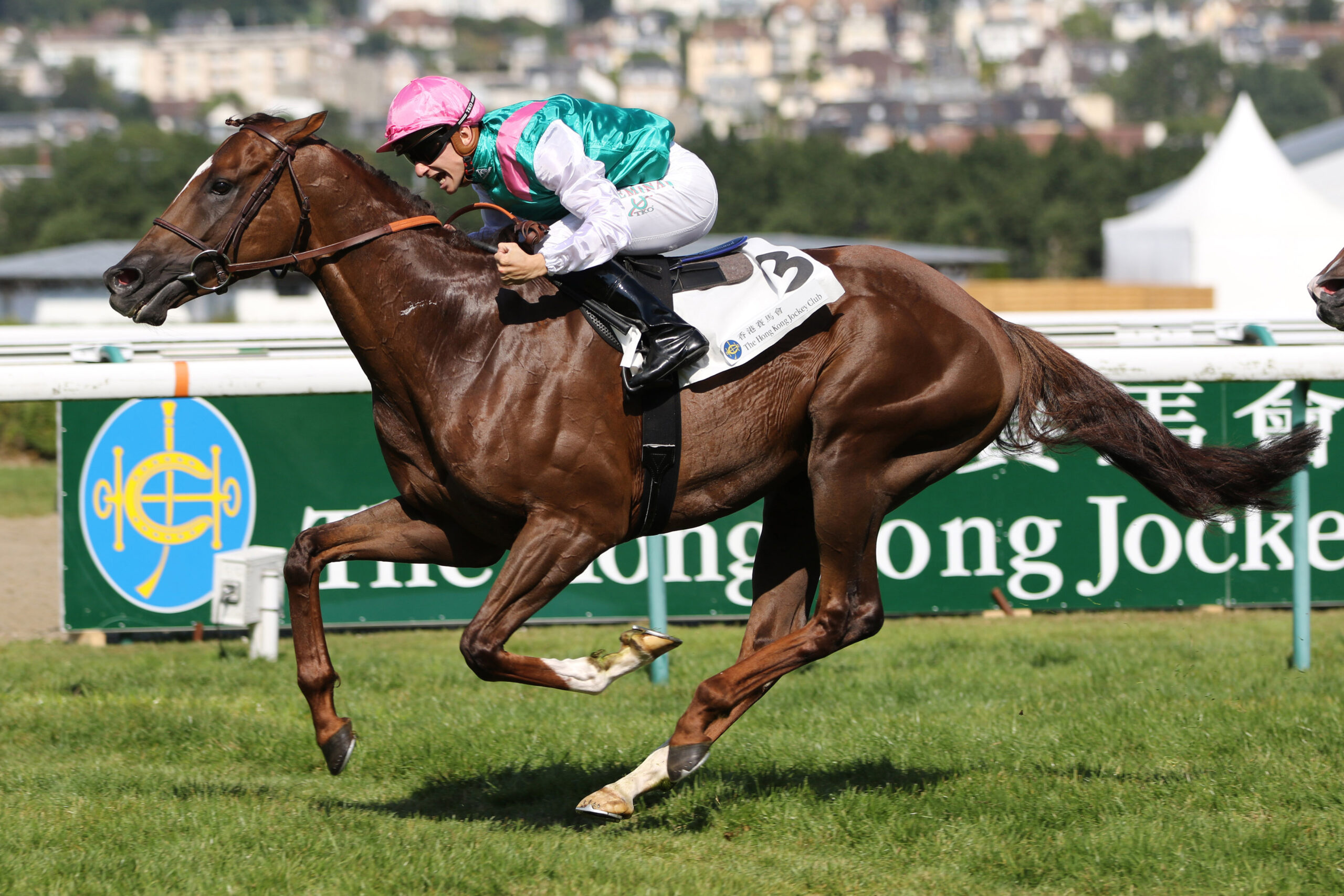
New Bay: will stand for a career high of €75,000 in 2023. Photo – Bill Selwyn
In his first three crops, none of which number more than 80 foals, New Bay is the sire of three Group 1 winners among eight stakes winners and ten stakes horses. As a result, he is popular in the sale ring, where his yearlings sold for up to 475,000gns this year, and has had his fee increased to €75,000 for 2023.
The son of Dubawi isn’t the only high-flying member of the roster, however. Stalwart Lope De Vega, also a French Classic winner trained by Fabre in his day, enjoyed another exceptional season, one that consisted of no fewer than 50 stakes horses, 27 stakes winners and Group winners on four continents. Leading the way were the French Group 1-winning fillies Place Du Carrousel, winner of the Prix de l’Opera for Ballylinch and Al Shaqab Racing, Prix d’Ispahan and Prix du Moulin winner Dreamloper and the Prix Vermeille heroine Sweet Lady. Hypothetical also won the Al Maktoum Challenge Round 3 at Meydan.
Stalwart Lope De Vega enjoyed another exceptional season, one that consisted of no fewer than 50 stakes horses, 27 stakes winners and Group winners on four continents
Lope De Vega also attracted his share of the headlines in the sale ring, most notably as the sire of a half-sister to Battaash who sold for 1.8 million guineas to Richard Knight at the Tattersalls October Sale.
Having once stood as low at €12,500, the son of Shamardal will stand his third consecutive season in 2023 at a fee of €125,000.
“He’s a phenomenon really,” says O’Connor. “He really is covering good mares. He made his name off mares well below those the standard of those he’s competing with now. When you go down through the barns of mares and see the names in there, the quality that he’s covering, it still gives me a thrill.
“He puts speed and class into them. He had a lot of speed himself – he had to come from last to first when he won the French Guineas. He’s had a lot of Group winners over 5f and 6f – he must be the only French Derby winner to sire a Cornwallis Stakes winner [Royal Razalma] in his first crop. We bred Belardo [winner of the Dewhurst and Lockinge Stakes], [Group 2 winner] Very Special and [Group 3 winner] Brown Sugar out of his first crop, and we knew then that he was a special sire.”
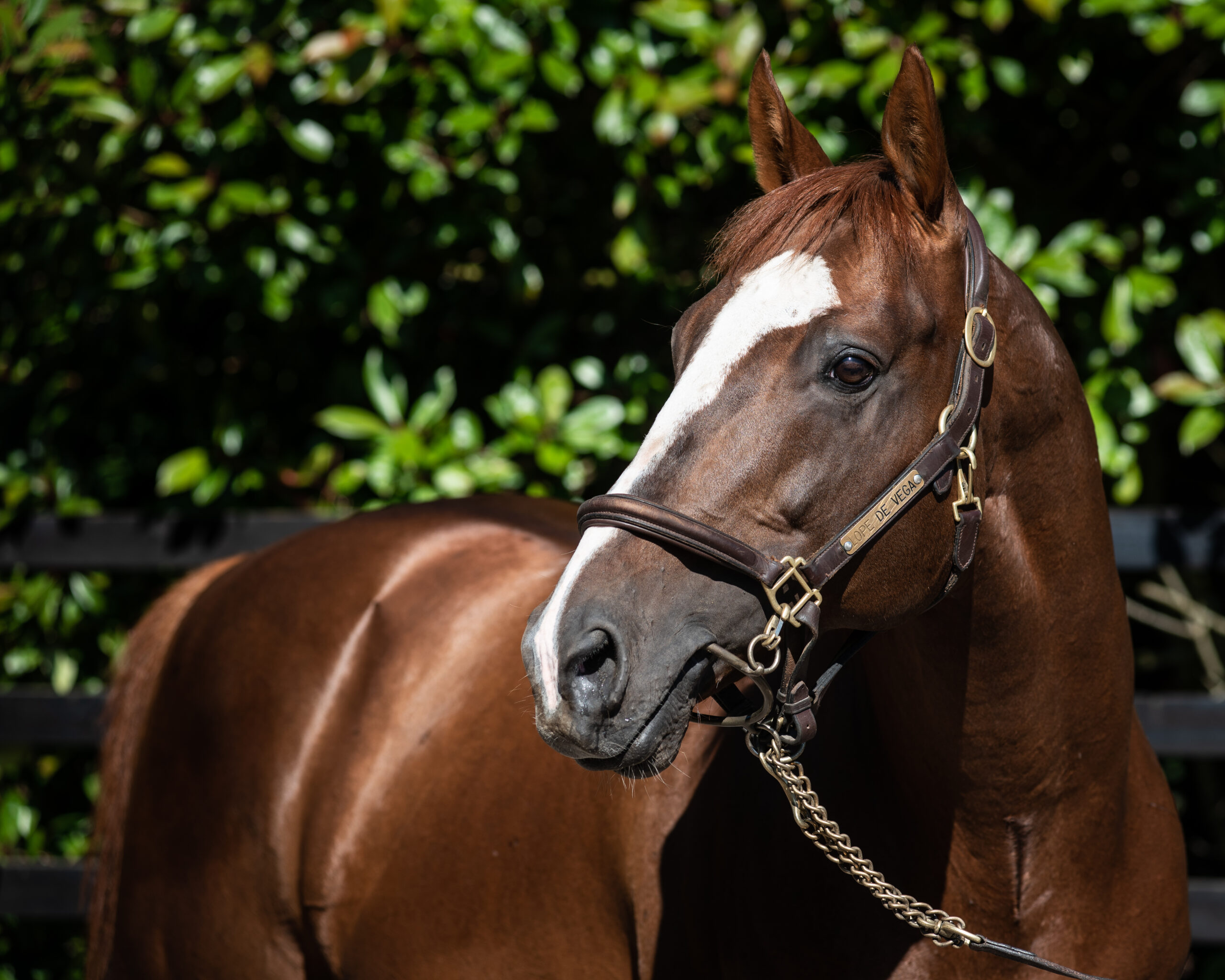
Lope De Vega: enjoyed another outstanding year in 2022. Photo – Ballylinch Stud
Lope De Vega now has a number of sons at stud, notably Belardo, Phoenix Of Spain and Lucky Vega, and although his oldest crop are ten-years-old, he is also making his mark as a broodmare sire, with two-year-old Group winners such as Persian Force and The Ridler among those to fly the flag.
“He certainly looks very promising as a broodmare sire,” says O’Connor. “One thing he definitely transmits is athleticism. There’s almost what you call a ‘Lope De Vega walk’ and I see some of his mares transmitting that. He’s inbred closely to Machiavellian and I’ve no doubt that is also coming into play – Machiavellian is a big influence, particularly in stallions.”
“He’s inbred closely to Machiavellian and I’ve no doubt that is also coming into play”
In what is an Andre Fabre-orientated roster, fellow Group 1 sire Make Believe, who defeated New Bay in the 2015 Poule d’Essai des Pouliches, stands for €10,000, an inexpensive figure considering his first crop included £11.6 million earner Mishriff, a top-flight winner on both turf and dirt.
It is also crunch time for fellow former Fabre trainee Waldgeist, whose first crop hit the track next year. Best remembered for his defeat of Enable in the 2019 Arc, the son of Galileo also defeated four subsequent Group 1 winners when successful in the Criterium de Saint-Cloud as a two-year-old prior to also winning the Grand Prix de Saint-Cloud and Prix Ganay as an older horse. Bred by Gestut Ammerland out of the famous German ‘W’ family that descends from Waldrun, he represents the same axis that launched Lope De Vega and has also been well supported by his co-breeder and racing owner Newsells Park Stud. He stands next season at €12,500.
“He has stock in training with Andre Fabre, Peter Schiergen and Chad Brown among many others,” says O’Connor. “We’ve also kept a good number to put into training.
“He was a very good two-year-old, which sometimes gets forgotten. I think Andre Fabre seldom runs a two-year-old in a Group 1 unless he thinks he is really a Group 1 horse. So it could be that his progeny surprises people with more precocity than they might think. And looking at them physically, he does put more muscle on to them than you might expect. They all have great temperaments as well.
“Like all young stallions, it’s up to him now. But he’s had good support throughout, and interestingly there won’t be a big drop in numbers in his second and third crops, especially after people liked the first foals last year.”
Despite its lengthy history, Ballylinch has remarkably only ever had three owners. During the later McCalmont era, it boasted a roster highlighted by the likes of Fortino, the sire of Caro, Arc hero Sassafras, the first horse to beat Nijinsky, and Appiani, sire of another Arc hero in Star Appeal. In 1987, it changed hands to entrepreneur Tim Mahony and under the management of O’Connor, in time stood Soviet Star as well as the popular dual-purpose stallion King’s Theatre. Today, the operation maintains a dual-purpose influence through its association with Fascinating Rock, Jukebox Jury and Sea Moon, all of whom stand with Victor Connolly at Burgage Stud in County Carlow.
In 2014, the farm changed hands – lock, stock and barrel – for only the third time in its history to John and Leslie Malone, whose involvement in the Thoroughbred industry also covers the acquisition of Bridlewood Farm in Florida. One of the largest land owners in the US, the transaction coincided with the purchase of the Kildare-based Castlemartin Stud for €28 million from Sir Anthony and Lady O’Reilly. Another farm, Broguestown Stud, is on a long-term lease from Michael Dalton, allowing the operation the flexibility of three properties with which to move the broodmare band and their followers. Ballylinch also houses a sizeable pre-training operation.
“John Malone had bid for both Ballylinch and Castlemartin at the same time,” recalls O’Connor. “He knew there were other people trying to buy Ballylinch, so he bid for both expecting to necessarily get one.
“So when he got both, he asked me integrate Castlemartin into the operation. I think it’s had a very positive impact on Ballylinch because Castlemartin is a wonderful farm with excellent land. We’ve put a lot of investment into it and we have a very good team of people there.”
“The mares are performing well and when that happens, you can expect that if you have some nice yearlings, then you will get paid, which is exactly what happened”
A season replete with Group 1 victories alongside a series of big auction returns highlighted by the sale of Place Du Carrousel’s half-sister by Kingman for 1,050,000gns to Shadwell makes 2022 hard to replicate. But with the stallion roster in such a powerful position and complemented by a such a deep broodmare band, the next few years could well see the stud reach even greater heights.
“We had a good sales season and we had a good racing season,” says O’Connor. “The mares are performing well and when that happens, you can expect that if you have some nice yearlings, then you will get paid, which is exactly what happened. We’ve got a strong broodmare band, the stallions are on a high and the horses in training are going well.”
He adds: “It’s unusual – I know how lucky it is to be able to find one good stallion. To have two firing at a high level at the same time from a roster that in 2022 consisted of only four horses is very fortunate. You have to be lucky to get that. Obviously, we’ve been trying and when it happens it’s fantastic.”
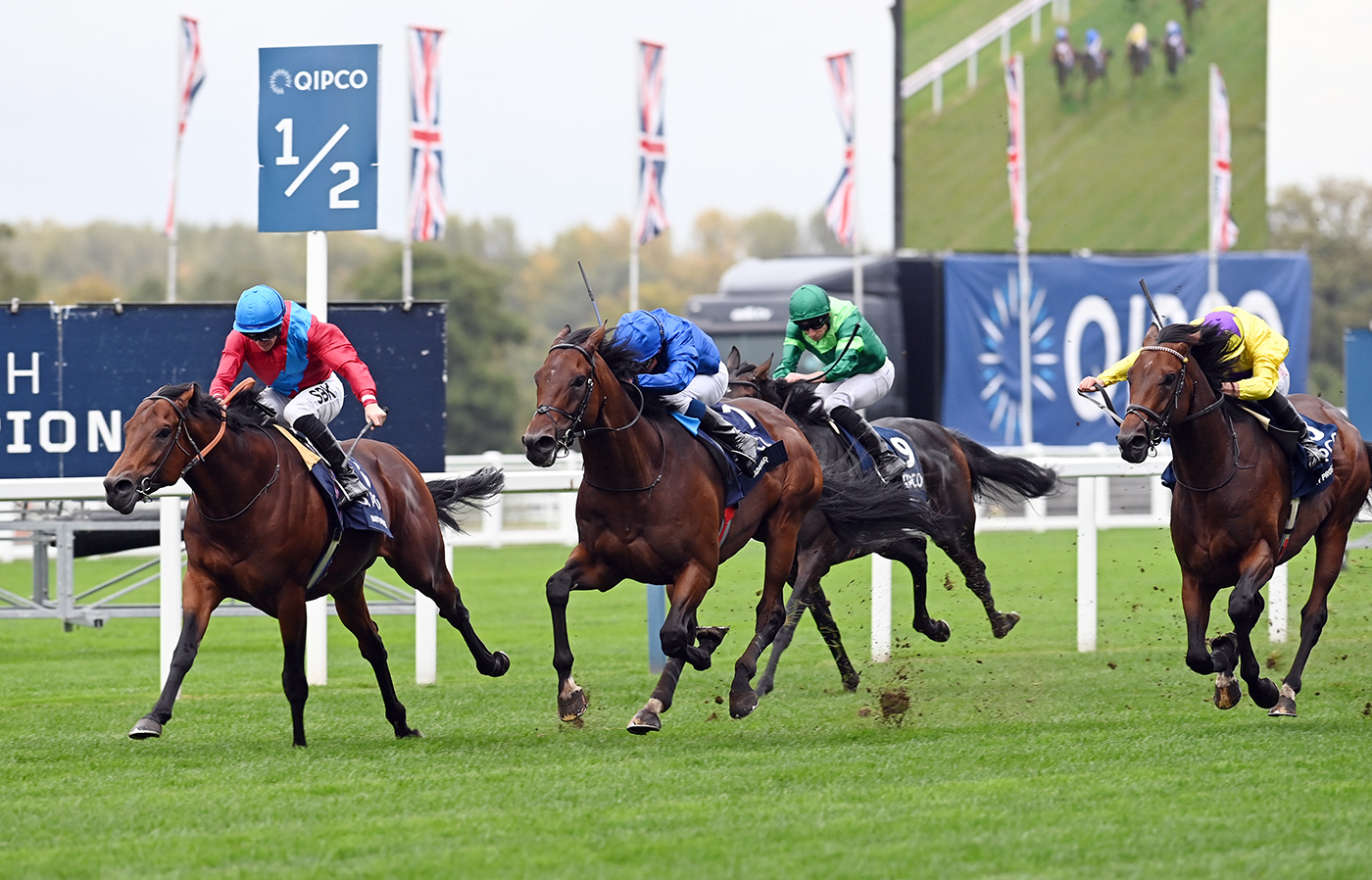
Bay Bridge (left): future Ballylinch stallion overcomes Adayar and Baaeed to win the Champion Stakes. Photo – Bill Selwyn
DAWN OF A NEW ERA
The addition of Queen Elizabeth II Stakes winner Bayside Boy to Ballylinch Stud’s roster could not be more appropriate given that the stud not only stands his sire New Bay but also bred the colt out of Alava.
Part of the stud’s yearling consignment at the 2020 Tattersalls October Sale, he was knocked down for 200,000gns to Richard Ryan on behalf of Teme Valley. However, so taken with the colt were Ballylinch that they retained a share.
“I have a lot of respect for Richard Ryan as a yearling judge,” says John O’Connor. “We had this very nice yearling by New Bay at Tattersalls and Richard said to me ‘I love this colt and I know lots of other people do as well and I might find it hard to buy him. So would you be interested in staying in?’. Well we loved the colt as well and that’s how the partnership began.
“New Bay had his first two-year-olds at the time, and in the days leading up to the sale, Saffron Beach and New Mandate won on the same day at Newmarket [Saffron Beach scored first time out while New Mandate landed the Royal Lodge Stakes]. So we knew then that New Bay was on a very steep upward trajectory.”
He adds: “Ironically, New Bay didn’t win as a two-year-old, although he was always held in high regard by Andre Fabre. But a few of the breeze-up people had some from his first crop that they really liked. So there was a little bit of a buzz about him in late spring and early summer, and then he kicked on ahead of the sales.
“They seem to have a determination that turns back many horses. That’s a Dubawi thing. If there are good sons of Dubawi who succeed at stud, I think that can only be good as there’s an intrinsic soundness and will to win in there that is beneficial for the breed.”
“With New Bay going to a much higher figure this year, we wanted to be able to offer a very good son of his at the same sort of region that New Bay started his own stud career at in the beginning”
Bayside Boy is also well-related on his female side as a half-brother to the dual Group 2 winner Forest Ranger and Listed-placed Home Cummins. Their dam Alava is a Listed-winning daughter of Anabaa.
“The dam is very good,” says O’Connor. “We bought her privately when Forest Ranger won his novice as a three-year-old at Newcastle. [Stakes-placed] Home Cummins was already on the page. Her two-year-old, Lord Of Biscay, won for us on debut in the autumn but then didn’t really handle the ground at Newbury [when unplaced in the Horris Hill Stakes]. I’d still be very optimistic about him next year. Alava is a mare who had ability herself and she passes it on regularly.”
Bayside Boy signed off his career in style when running down Modern Games and Jadoomi to take the Queen Elizabeth II Stakes but he was also a smart two-year-old whose his performances included a win in the Champagne Stakes at Doncaster and placings in the Dewhurst Stakes and Vertem Futurity. He retires as the winner of four races and is set to stand his first season for €15,000.
“Bayside Boy ran some very good splits for those last couple of furlongs at Ascot,” says O’Connor. “There was a temptation to keep him in training. Both William Buick, who rode him when he won the Fortune Stakes at Sandown, and Tom Marquand, who rode him at Ascot, said they struggled to pull him up – they both said he had loads left in the tank at the end of those races.
“But with New Bay going to a much higher figure [€75,000], we wanted to be able to offer a very good son of his at the same sort of region that New Bay started his own stud career at in the beginning. So those breeders who supported New Bay early on will also have the opportunity to support Bayside Boy. That’s the thinking, anyway.”
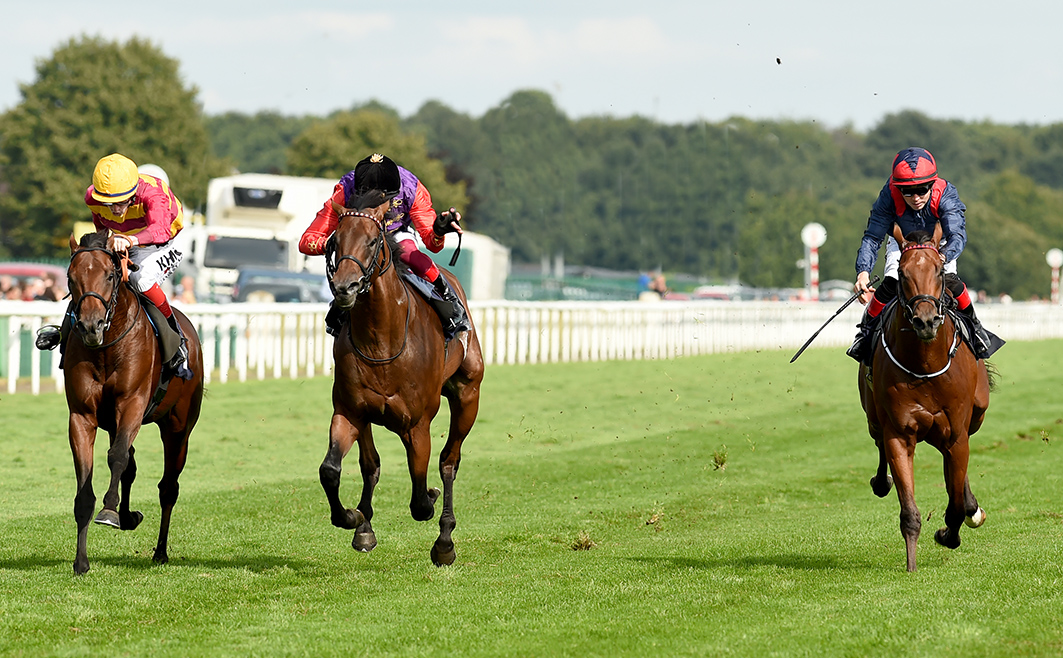
Bayside Boy (left): Group 1 winner retires to stand alongside his sire New Bay. Photo – Bill Selwyn


